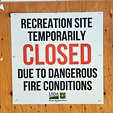All Articles
Legislative and Regulatory Update
May 2003 by Staff
• DOI limits WildernessThe Department of Interior (DOI) notified Congress that it intends to halt all reviews of public lands for wilderness protection and to withdraw protected status from approximately 3 million acres in Utah.
By suspending wilderness reviews, DOI would limit the amount of land under consideration for wilderness to 22.8 million acres nationwide.
The suspension decision is part of a settlement in a lawsuit filed by Utah, which had yet to be approved by the federal judge in the case at press time.
In 1976, Congress asked DOI to inventory wilderness and potential wilderness areas and provided a deadline of fifteen years for the agency to complete the inventory. However, the Bureau of Land Management (BLM) continued adding to their list of potential wilderness areas beyond the 1991 deadline.
Interior Secretary Gale Norton also stated she is setting aside the 2001 Wilderness Handbook, which is a policy guidebook provided to the BLM during the final days of the Clinton administration. The Wilderness Handbook required the BLM to protect potential wilderness areas even if these areas were identified after the 1991 deadline for inventory. The requirement created millions of acres of de facto wilderness, even though only Congress can make such designations.
Utah had sued the DOI during the Clinton administration over a reinventory conducted by his Interior Secretary, Bruce Babbitt.
“It looks like Interior agrees with me and my Western colleagues that the BLM does not have the authority to designate new wilderness study areas, …doesn’t have authority beyond what Congress gave it,” said Senator Orrin Hatch (R-Utah). “Secretary Norton’s actions will bring resolution to the illegal activities of the past administration.”
• Current California administration solidifies anti-mining stance
The California State Mining and Geology Board (SMGB) adopted another emergency regulation, extending backfilling requirements state-wide for large open-pit metal mines. This pretty much eliminates any new large-scale metal mining in the state until a more friendly administration is put in place because of the costs associated with backfilling.
SMGB members are appointees of Governor Gray Davis.
The California Surface Mining and Reclamation Act provides an exemption for smaller operations under section 3505.
§ 3505. Special Provisions.
(a) Exemptions.
(1) In addition to the provisions of Public Resources Code Section 2714(a), (c) and (d), any surface mining operation that does not involve either the removal of a total of more than 1000 cubic yards of minerals, ores, and overburden, or involve more than one acre in any one location, shall be exempt from the provisions of the Act.
The latest emergency regulation, adopted April 10, 2003, also excludes open-pit mines that had an approved reclamation plan and financial assurance in place as of December 18, 2002.
The SMGB’s emergency regulation states, “No technical, theoretical, empirical studies, reports, or documents were prepared or relied upon by the SMGB in its consideration of this rulemaking.”
I had an odd conversation with Kit Gonzalez, executive assistant to the SMGB. I contacted her to clarify if the above statement regarding documentation pertains to the backfilling requirement. She replied, “That’s correct.”
“How is it possible to justify a decision when there’s no supporting or opposing documentation?”
Gonzalez replied, “No one submitted any documents.”
When asked if they considered comments or reports submitted by organizations such as the California Mining Association (CMA), Gonzalez stated, “We believe we rebutted their comments effectively.”
“Don’t you consider that a document?” I asked.
After a long pause, Gonzalez replied, “Well, they can contest the backfilling requirements when the final rule is published in June.”
The SMGB also concluded that the emergency regulations would not adversely impact the ability of California businesses to compete with businesses in other states and will not create or eliminate jobs.
Gonzalez responded, “We don’t believe that any jobs will be lost or hurt by this.”
“By the backfilling requirement?” I asked.
“That’s correct,” stated Gonzalez.
Adam Harper, manager of the California Mining Association (CMA), compared the new regulations to a form of environmental imperialism.
“California will continue to use and consume huge quantities of metals, but will not bear any of the responsibility for mining,” stated Harper. “We already had the most strictly regulated mining industry in the nation.
“Who is going to spend money on exploration in California, when they know they can’t afford to develop it?” asked Harper.
Harper stated the CMA is currently busy with several lawsuits, but expects an individual mining company may challenge the new SMGB regulations in court.
The entire text of the regulation can be viewed on the Internet at www.consrv.ca.gov/SMGB/Regulations/rvsedtxt3701.pdf
The Surface Mining and Reclamation Act is available on the Internet at www.consrv.ca.gov/OMR/smara/index.htm
Printed copies are available by calling (916) 445-6199. There is a fee of $25 for the Surface Mining and Reclamation Act. Ask for “Publication 51.”
• Juneau welcomes miners
A city advisory board in Juneau, Alaska, has approved changes to the city’s mining law to encourage mining. New rural mines would be considered an allowable use and would not be subject to permitting conditions that are already covered by federal or state environmental reviews. The proposal would also allow the city’s community development director to grant summary approval to changes at existing mines.
The Juneau Planning Commission would retain some oversight, and could add conditions relating to noise, erosion, traffic, and other issues.
The current ordinance requires a duplication of state and federal reviews by the city.
• Bill would restrict public land purchases
Representative Sam Graves (R-Missouri) is pushing legislation to place a moratorium on public land purchases made through the Land and Water Conservation Fund.
“It just peeves me to no end to know that they continue to buy up this land, and they won’t take care of what they already have,” said Graves. “They own one out of every five acres already. At least in areas like Missouri, it takes land off the tax rolls. They do have payments in lieu of taxes, but they’re never the amount they would have been on private land.”
Under the Graves bill, money from the federal fund, which comes from offshore oil and gas drilling, would pay for maintenance and improvements instead of land acquisition.
• Barrick wins suit against EPA reporting requirements
A US District Court has ruled against an Environmental Protection Agency (EPA) rule that required Barrick Gold Corp. to report all waste rock that was moved during mining operations.
Barrick said the court ruled that the EPA “had erroneously interpreted the Emergency Planning and Community Right-to-Know-Act by requiring the industry to report the movement of rock as if it were a toxic release to the environment.”
The EPA issued the directive in 1999 under its Toxic Release Inventory Program, and Barrick challenged it in court that same year.
Barrick said it viewed the requirement as misleading since trace minerals are naturally occurring and aren’t released when they are moved out of the way to get to a mineral deposit.
• Utah obtains rights-of-way on federal lands
The Department of Interior (DOI) and the state of Utah signed a landmark agreement in April aimed at resolving the uncertainty about existing RS 2477 rights-of-way claims on federal land. The agreement does not apply to national parks, refuges and wilderness areas.
Revised Statute 2477 was a simple, straightforward law established in 1866, which stated, “The right-of-way for the construction of highways across public lands not reserved for public purposes is hereby granted.”
No federal agency has the authority to close an RS 2477 road for any reason. The Clinton administration went so far as to change the definition of a road to assist them in closing public lands during their Roadless Inventory.
RS 2477 was repealed in 1977 with the passage of the Federal Land Policy Management Act, but Congress specifically stated “Nothing in this Act, or in any amendments made by this Act, shall be construed as terminating any valid lease, permit, patent, right-of-way, or other land use right or authorization existing on the date of approval of this Act.”
Interior Secretary Gale Norton called the agreement with Utah a model that other state governments could follow.
Previously, the only methods available to clarify rights-of-way across federal lands was through Congressional action or through the courts.
The memorandum of understanding (MOU) only applies to existing roads that were and continue to be publicly traveled and regularly maintained. Individual counties in Utah may still want to assert RS 2477 rights to open pre-existing rights-of-way that may not have been covered by the agreement.
More information about RS 2477 rights-of-way is available on our website (www.icmj.com) under the “Additional Resources” heading.

Indicators and Hillsides
 The placer gold shows up in ground sluice areas, hydraulic pits, secondary channels and hillside diggings. It is coming down the hillsides from an ancient channel left high and dry millions of years ago.
The placer gold shows up in ground sluice areas, hydraulic pits, secondary channels and hillside diggings. It is coming down the hillsides from an ancient channel left high and dry millions of years ago.
Melman on Gold & Silver
Clearly, the single-most important reason for the latest decline in gold is the recently announced auctions by the British Central Bank. However, other news stories this past month also had negative implications for the yellow metal.
Looking Back
Excerpts from California Mining Journal, our original title, published 50 years ago this month.
National Forest Closures in California
 I found I could not go prospecting in areas where I did not have a mining claim and the Forest Service thought my mere presence was a danger to the forest.
I found I could not go prospecting in areas where I did not have a mining claim and the Forest Service thought my mere presence was a danger to the forest.
"Gold" Coin Debuts
For the first time, the Sacagawea Golden Dollar changed hands, intermingling with scuffed quarters and nickels, setting itself apart with its golden hue.
Trout Thriving In Treated Mine Water
West Virginia University water scientists have found that rainbow trout can survive in previously polluted waters.
Subscription Required:
The Ball Mill
• Our Readers Say
• WMD Raffle Raises Funds for Lawsuit
• Gold in Alabama
• From the Editor
• Yukon Placer Miners Fighting Extreme Discharge Limits
• Picks & Pans: Red Beryl Mining—Beaver County, Utah
• The Investigation
• A Gold Detector Sitting in a Closet Only Finds Dust—A Potpourri of Detector Tips
• Central Coast Ranges
• Poll: Montana in Favor of Repealing Anti-Mining Initiative
• Platinum in Laccoliths
• Mining Stock Quotes and Mineral & Metal Prices
• Looking Back
• Melman on Gold & Silver








